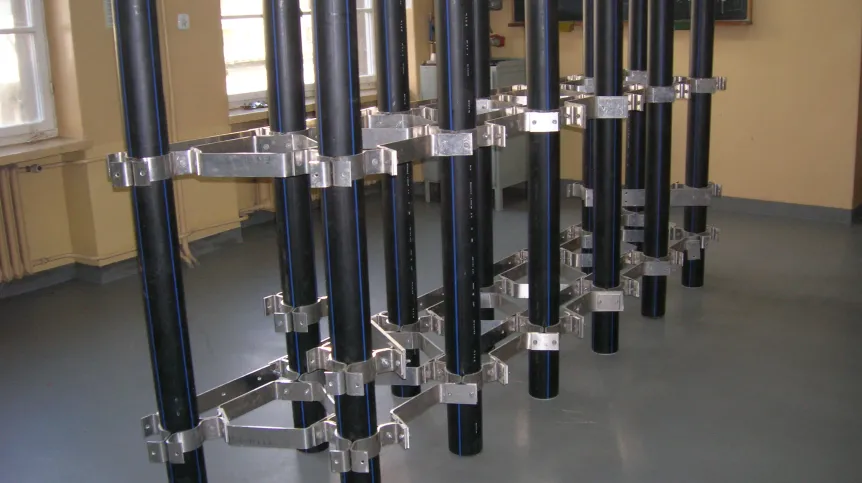
Every year, storm waves take about 34 hectares of Polish territory. Costs of coastal protection and repairing damage caused by the sea are very high. A device that can suppress waves has been developed and patented by Prof. Bolesław Kuźniewski of the Maritime University in Szczecin.
Active sea shore protection technology is based on the suppression of waves before they reach the shore. This concept involves calming the sea using its own energy.
The unique breakwater is fully immersed in water and built from a few dozen to a few hundred meters from the shore. It consists of vertically aligned floats connected with rigid brackets. These floats are sealed polyethylene tubes filled with air, which suppress wind waves. Weight of the device is much lower than the buoyant force of water. It is stabilised under the water surface with ropes anchored to the bottom.
"The forces caused by waves offset on the components of the device, whose mutual distance in the wave direction is equal to half the wavelength. At the same time, together with the compensation of forces the energy of waving water dissipates and the height of the waves decreases. This effect can be enhanced by adding parts with improved damping properties" - explained Prof. Kuźniewski.
The rigid structure is based on an equilateral triangle, where the side length defines the distance between tubes. It ranges from one to several meters.
The design was developed in the framework of an R&D project "The new method of protecting the coast against sea waves" at the Maritime University in Szczecin, in the years 2008-2010. The project manager was Dr. Zenon Grządziel. The research team consisted of eight members. National Research and Development Centre allocated about two million zlotys to the project.
Experimental pilot study of attenuation of sea waves has been carried in the model basin of the Ship Hydrodynamics Division of CTO SA in Gdańsk. It confirmed the correctness of developed structure.
The breakwater developed at the Maritime Academy is designed primarily to protect small ports and built-up coastlines. Scientists are certain that it will work in the sea and that it is a universal device that will suppress waves not only in the Baltic, but wherever someone will be willing to implement the Polish innovation.
"The need to improve coastal protection technologies is justified, because in recent years we have observed an increase in strength, duration and frequency of storms. Particularly vulnerable to damage are high and steep cliffs, of which we have about 50 kilometers in Poland" - said Prof. Kuźniewski.
He named specific locations of utility, residential buildings and other objects on the shore. These are so-called active cliffs, where the sea has been attacking land for centuries. In these places, in his opinion, it would be advisable to set the new sea breakwaters. According to the scientists, cliff shores are difficult to protect, and strengthening them using classical methods is very costly.
"This innovative method can also be used to protect small ports on the Baltic Sea. They are completely unprotected and during a storm you can neither enter the port or leave it. The storm interferes with the operation and normal functioning" - said the author of the patent.
Prof. Kuźniewski had an idea for his invention while conducting research in other areas of physics. He conbsidered the mechanics of waves and came to the conclusion that their own energy can be used to protect the sea shores.
The new coastline storm protection method is environmentally friendly, does not change the appearance of the shore, lowers maintenance costs in condition of undiminished tourist and recreational values of coastal municipalities .
Professor emphasizes that research in marine conditions is necessary for the practical application of the innovation. The device is lightweight and portable. In order to check how it will work in the sea, it can be assembled in one location, and then transported to another. The estimated producion cost of the modern breakwater, is lower than strengthening the coast with traditional passive methods.
Common shore protection against sea waves involves building breakwaters, dams, concrete or stone levees. The disadvantage is the fact that such permanent structures change the natural appearance of the sea coast, reduce its recreational value, are not environmentally friendly, and in addition expensive.
PAP - Science and Scholarship in Poland, Karolina Olszewska
kol/ ula/
tr. RL













